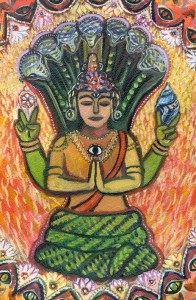The Yoga Sutra of Patanjali is one of the foundational yoga texts.
The Yoga Sutra were transmitted orally for centuries and then this oral tradition was systematized and put into written form by the Sage Patanjali in approximately 500 B.C.E. Numerous sages and scholars have translated and commented on the Yoga Sutra over the course of time and this wisdom is available to the modern yoga aspirant.
I recommend my teacher, Bhavani Maki’s book, The Yogi’s Roadmap as an accessible introduction to the Yoga Sutra as well as a wonderful reference with a Sutra glossary and guides to the original Sanskrit language. My other favorite translations include The Yoga Sutra of Patanjali by Swami Satchidananda and The Yoga Sutras of Patanjali, Study Guides for Book I Samadhi Pada and for Book II Sadhana Pada, by Baba Hari Das.
There are a wealth of others including Light on the Yoga Sutra by B.K.S. Iyengar. Patabbhi Jois is known to have said that if one reads ten different translations, ten times each, we begin to have an understanding of the Sutra.
The Sutra, or literally threads, are brief capsules of wisdom. The Yoga Sutra is comprised of 196 aphorisms organized into four books, or padas: Samadhi Pada on Concentration, Sadhana Pada on Practice, Vibhuti Pada on Powers, Kaivalya Pada on Freedom. The Yoga Sutra, systemitized by Patanjali 2000 years ago. are chanted and memorized in the original Sanskrit which can feel awkward and intimidating at first, but slowly the tongue learns new techniques as the Sanskrit plays in the mind and on the lips. Practice implies repetition and with some practice the student will develop competency and devotion for the Sutra as living wisdom.
“The term sutra comes from the Sanskrit root su, which means ‘to join together’ and tra, ‘in order to transcend’; the English word suture, derives from the same root su. The Sutra are the thread that links the teacher, the teaching, and the student together. They are the structure underlying the process of Yoga, and as the warp and weft of the fabric of the teachings, they serve to keep us thread straight and in line. Speaking to the very fabric of our being, they offer us timeless insights that can be woven into our lives, addressing the psyche, our potential and struggles, as well as our means to resolution, freedom and peace.” Bhavani Maki, The Yogi’s Roadmap.
Patanjali: Teacher/student tradition. Teaching to each student individually. Teacher to connect the map to the destination; guide or tracker. Each must walk the path—charya, to walk the talk.
Sherry has a passion for the Yoga Sutra as a living text and guide for our daily lives. She offers satsang, a community of truth, to share the Sutra in chanting and discussion.

